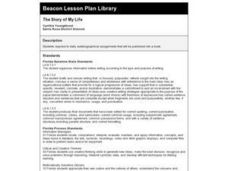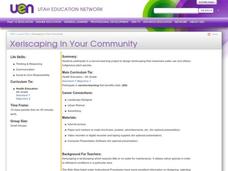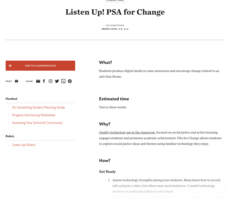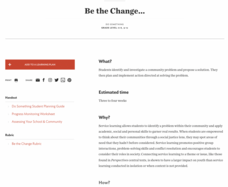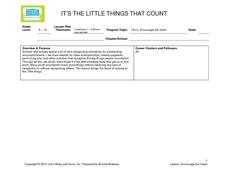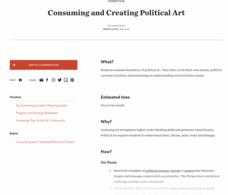Curated OER
The Story of My Life
Learners complete autobiographical writing assignments throughout the school year that they save and rewrite to put into a published book during the last month of class. They include photographs, drawings and mementos of their lives in...
Curated OER
Preserve is the Word
Young scholars investigate a list of archaeological ethical questions. They select a question/issue and design a 3-minute (maximum) PSA to persuade the public to agree with their idea. They conduct research or interviews with experts to...
Curated OER
Air Quality and Transportation
Second graders observe car pooling patterns and the important role car pools play in reducing air pollution. They explain how they get to school and graph the types of transportation that is used. Students make a list of the different...
Curated OER
Xeriscaping In Your Community
Fourth graders participate in a service-learning project. They design landscaping that maximizes water use and utilizes indigenous plant species. Afterward, they advertise and present their xeriscape garden at a school function such as...
Curated OER
Diversity of Trees
Fourth graders explore the uses of trees, In this trees lesson, 4th graders discover the uses of trees and how we use them everyday. Students collect items and decide if they are made from trees, have a scavenger hunt for wood products...
Curated OER
Positively Respectful
Create a positive environment by teaching students to show respect and share compliments. Students use drawing paper and create a self-portrait. Students are encouraged to discuss things they like about themselves. As students share...
Curated OER
Building Bridges for Young Learners--Culture
Students explore the concept of "culture." In this cross curriculum literacy and world history lesson, students listen to a letter written by a child from Namibia, then compare and contrast life in Africa with their own life. Students...
Curated OER
Instrumental Rehearsals for Excellence - Lesson 3
Students identify some characteristics of successful music teachers and rehearsals. They develop a list of criteria for evaluating the quality of a performance, and apply those criteria to a specific performance.
Curated OER
Families and Neighborhoods
Students investigate the characteristics of a neighborhood. In this communities lesson, students read the book Franklin's Neighborhood and list people and places in their community. Students create a neighborhood mural.
Curated OER
Representing Constraints
What are constraints and how can they be represented mathematically? This instructional slideshow provides an explanation and an example of how to translate constraints into algebraic inequalities.
Teaching Tolerance
Listen Up! PSA for Change
Challenge scholars to speak up about a topic by creating a public service announcement or social media blitz about an issue they feel passionate about. Have them research their issues, then decide the best way to take their messages to...
Teaching Tolerance
Be the Change...
An engaging lesson empowers individuals to make a difference in the community. Pupils work together to identify problems within the community and draft possible solutions. Scholars then take it to the next level by volunteering their...
John Wiley & Sons
It's the Little Things That Count
Encourage your young leaders to acknowledge small victories and the unique abilities and strengths of others. Class members are assigned to observe a classmate and note their talents and interests, concluding in an "awards...
District 158
Plan an Adventure
For kids, taking a vacation is all fun and games, but after completing this pre-algebra project, they'll have a whole new appreciation for the planning that makes these trips possible. Given a budget of $5,000 to spend on purchasing the...
Rainforest Alliance
Who Takes Care of the Maya Forest Corridor?
Who keeps animals safe? Who keeps us safe? Discover the helpers that make learning and growing possible through a medley of activities that focus on habitats—ours and those in the rainforest. Scholars are asked to identify one...
US Institute of Peace
Organizations Working for Peace
We're all in this together! Show young scholars that peace is a process and having the support of like-minded people can make it happen. 13th in a series of 15 peace building activities, groups conduct research on a peace organization,...
Teaching Tolerance
Journalism for Justice
Roll the presses! Or at least have your class members participate in the time-honored tradition of the student press by creating their own newspapers or journalist pieces on a social problem. After conducting research and collaborating...
Scholastic
The First Thanksgiving Feast
Following an online activity, scholars listen to a read-aloud of If You Were at the First Thanksgiving by Anne Kamma. Pupils discuss their family traditions and complete a T-chart comparing the holiday then and now. Collages are made to...
US Institute of Peace
What Does It Take to Be a Peacebuilder?
Is the spirit of peacebuilding already inside you? Scholars take a closer look at the characteristics of peacebuilders, past and present, in instructional activity 13 of a 15-part series. Individuals identify common traits of...
Kenan Fellows
Unit 1: Introduction to Biotechnology
Biotechnology is big! Introduce the uses of biotechnology to science scholars with a fascinating, fact-filled unit. The first installment in a series of four biotechnology units covers the role biotechnology plays in human and...
National Research Center for Career and Technical Education
Business Management and Administration: Compound Interest - A Millionaire's Best Friend
Many math concepts are covered through this resource: percentages, decimals, ratios, exponential functions, graphing, rounding, order of operations, estimation, and solving equations. Colorful worksheets and a link to a Google search for...
DiscoverE
Creepy Putty
Mold your learners into materials engineers. Using glue, Borax, and water, scholars create a viscoelastic material. But your class might know it by another name—Silly Putty.
Channel Islands Film
Dark Water: Lesson Plan 2 - Grade 3
A discussion of bioluminescence launches an investigation of animal adaptations. After re-watching the opening minutes of Dark Water, class members listen to a reading of What Do You Do with a Tail Like This, and then create a new...
Teaching Tolerance
Consuming and Creating Political Art
A picture is worth a thousand words, but political art may be worth even more! After examining examples of political cartoons, murals, and other forms of public art, class members create their own pieces to reflect their ideals and...
